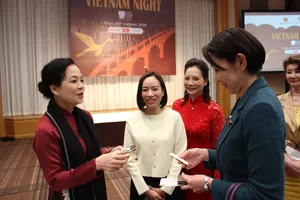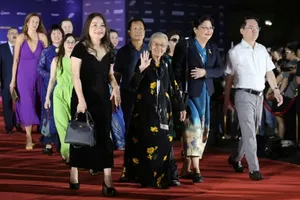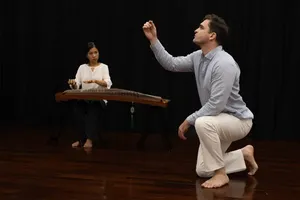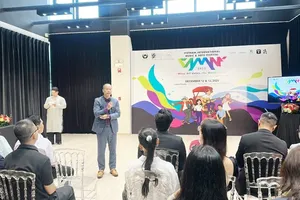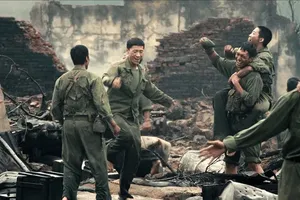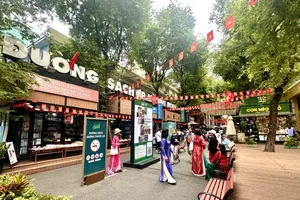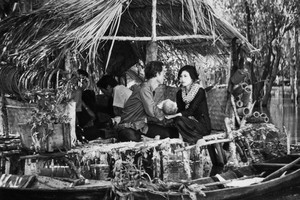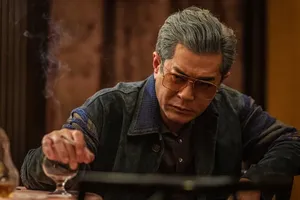
Within its opening week, “Den Am Hon” (The Soul Lantern), directed by Hoang Nam, achieved impressive box office figures, earning over VND44 billion (US$1.73 million) in its first three days from February 7-9. This performance closely trailed “Nu Hon Bac Ty” (A Billion-dong Kiss), directed by Thu Trang, and significantly outperformed “Bo Tu Bao Thu” (The Trouble Quartet), directed by Tran Thanh. The film also sparked considerable online debate, garnering praise for its polished execution, especially considering it was a debut feature.
Notably, beyond the diverse analyses and critiques of the film’s merits and shortcomings – encompassing script, setting, and acting – numerous comparisons arose with the acclaimed film of the Republic of Korea “Exhuma”. The exorcism scene, performed by Hoang Kim Ngoc, became a particular point of comparison. However, this scene in “Den Am Hon” while drawing some parallels, was meticulously crafted by the Vietnamese filmmakers and deeply rooted in Vietnamese cultural traditions.
Recently, Vietnamese cinema has prominently showcased a trend of revisiting, exploring, and celebrating indigenous cultural values, local identities, and a distinct Vietnamese character.
Examples include “Linh Mieu: Quy Nhap Trang” (Lynx: Spirit Possession – directed by Luu Thanh Luan), which blends spiritual and horror elements with an exploration of Hue's cultural beauty, depicted through familiar imagery such as the “luc cung hoa dang” (the dance of six lantern offerings) imperial dance, the art of ceramic inlay, and the lantern-releasing ceremony.
While not a commercial triumph, “Sang Den” (Lights On), directed by Hoang Tuan Cuong, offered authentic and vibrant portrayals of the itinerant lives of a Cai Luong opera troupe during a period of decline. Amidst societal shifts and personal dramas, the film captures not just nostalgia but also the determined efforts to preserve this traditional art form.
Previously, the success of films like “Ma Da” (The Drowning Spirit) grossing over VND127 billion ($5 million) and “Cam” (over VND100 billion - $3.9 million) stemmed from their fusion of the currently popular horror genre with traditional folk narratives. This formula proved highly successful in attracting large audiences to cinemas.
In 2025, Vietnamese cinema will continue this trend with a range of productions based on traditional cultural values, including “Nha Gia Tien” (Family Ancestral Shrine), directed by Huynh Lap, “Quy Nhap Trang” (Spirit Possession), directed by Pom Nguyen, and "Hoang Tu Quy” (Prince of Demons), directed by Tran Huu Tan.
According to numerous cultural experts, evaluating the success of Vietnamese films grounded in indigenous culture requires more than just observing superficial elements like settings, costumes, props, or cultural symbols. Crucially, the underlying spiritual values embedded within each work must be considered. These values contribute to celebrating a distinct “Vietnamese identity”, enabling Vietnamese cinema to vibrate with audiences both domestically and internationally.
Director Huynh Lap revealed that he explored nine different narrative directions while developing the script for “Nha Gia Tien”. “Some young people question the meaning of burning incense for ancestors or express curiosity about death anniversary meals and their organization”, he explained. “This inspired me to create "Nha Gia Tien" to share my understanding of Vietnamese ancestral worship. Therefore, despite being marketed as horror, the film is actually more focused on spiritual culture.”
Director Pham Ngoc Lan, winner of the Best First Feature award for “Cu Li Khong Bao Gio Khoc” (Cu Li Never Cries) at the 2024 Berlin Film Festival, once commented that when screened abroad, audiences are only familiar with the most iconic and visible symbols of Vietnamese culture, without understanding the deeper cultural layers.
Conversely, when screened domestically, Vietnamese audiences readily recognize the unique and familiar cultural nuances. These include the irreplaceable value of family bonds and the power of forgiveness as a comfort for loneliness, helping characters overcome past grievances and the complexities of their present realities.
This demonstrates that Vietnamese cinema has effectively tapped into the deep emotional undercurrents of its viewers, creating a powerful resonance. It also proves that combining entertainment with humanistic values rooted in cultural identity and a distinct Vietnamese character is not only possible but also a potent formula. This is the key for Vietnamese cinema to achieve broader success with audiences both at home and abroad.
